Affiliate disclosure: This post may contain affiliate links. Please see our Privacy Policy.
Chokecherry recipes can be hard to find, but that doesn’t mean they aren’t delicious. Though people have mostly forgotten how to prepare this once common wild food, I’ve tracked down plenty of tasty recipes using chokecherries to try at home.
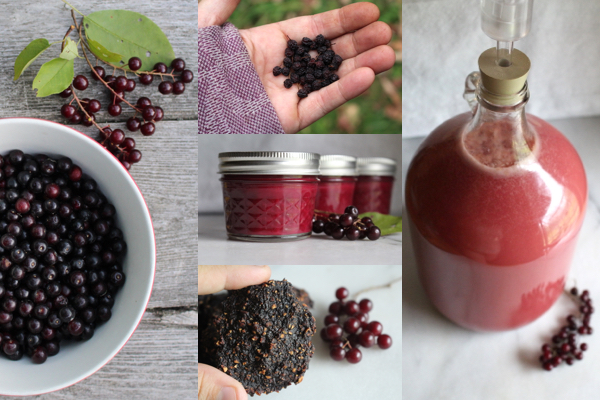
Chokecherries (Prunus virginiana) were once a staple food for the indigenous peoples of North America, and in many places, they’re still harvested in mass to make traditional delicacies as well as modern chokecherry recipes.
They’re incredibly abundant, and it’s often easy to harvest buckets of them in just a few hours of effort.
Unlike other stone fruits which grow individually, chokecherries grow in bunches. Their reproductive strategy relies on them being harvested by mammals grabbing handfuls of fruit at a time. It doesn’t matter if the harvesters are bears, raccoons, or humans, hands make quick work of the fruit clusters.
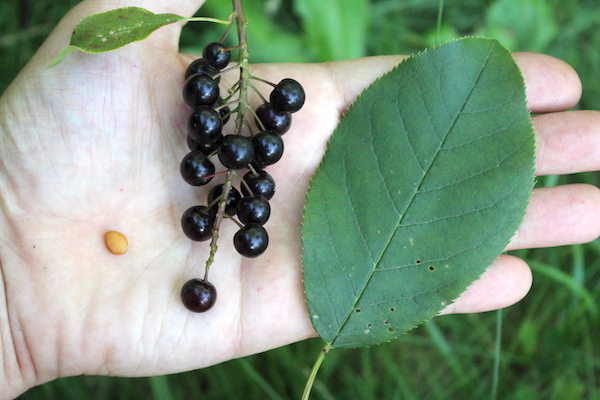
The name “choke-cherry” doesn’t exactly sound mouthwatering, but don’t let it fool you. The unripe fruit are indeed astringent, but if harvested dead ripe chokecherries are absolutely delicious. We eat them right off the bush, but that said, my family’s used to tart wild foraged fruit.
Most people make chokecherry jelly or wine with the fruits. That’s process starts by cooking them whole with a bit of water until they fall apart and then straining out the pulp and pits with cheesecloth or a jelly bag.
Indigenous chokecherry recipes and processing methods don’t remove the pits at all.
Are Chokecherry Pits Toxic?
Now you’re thinking…don’t chokecherry pits have toxins?
Yes, they actually do, just like the pits of other stonefruits like regular cherries, peaches, and plums. Believe it or not, this traditional process denatures the toxins.
According to the South Dakota State University Cooperative Extension Service:
“Chokecherries have a pit in the center that contains a naturally occurring hydrocyanic acid (also called prussic acid, a weak acid smelling of almonds). The process of either boiling or drying will neutralize the acid to make the food safe to eat. Traditionally, chokecherries are preserved by sun-drying. When the drying chokecherries, the whole fruit (pulp, skin, and pit) is ground together. Patties are formed and set to dry in the sun; this process is dependent on consecutive days of hot, windy weather.”
Still, as always, use your best judgment. It’s your health and you’re ultimately responsible for what you put into your body, and food allergies, especially given a completely new food, are always a possibility. If you don’t feel comfortable consuming chokecherry pits, then don’t.
Chokecherry Recipes
I’ve included both modern and historical chokecherry recipes in this list, and I’ll leave it up to your own best judgment as to whether or not you’d like to try processing them in traditional ways (with pits) or more modern methods which remove the pits.
Be aware that chokecherries are quite small and generally clingstone, so the best way to remove the pits is by cooking then straining. It’s unlikely you’ll be physically able to individually pit the fruit, even if you did somehow have the patience for the monumental task.
Chokecherry Juice
The simplest way to use chokecherries is to just make chokecherry juice.
Start by cooking the chokecherries in a covered saucepan with a small amount of water on the stove. In about 15 minutes they should have completely fallen apart and the pits should separate from the fruit pulp with gentle stirring. (Be gentle, don’t crush the pits.)
After that, strain through a piece of cheesecloth or a jelly bag to extract the juice.
I’ve found that it takes roughly 5-6 pounds of fresh chokecherries to make about 4 cups (1 quart) of juice. It’ll be cloudy, and that’s from the natural pectin present in the juice. If you want a bit more clarity, simply refrigerate the juice overnight and much of that will settle out.
Making chokecherry juice is the first step in most modern chokecherry recipes, and it’ll be quite tart. Feel free to add sugar, honey, or maple syrup to taste.
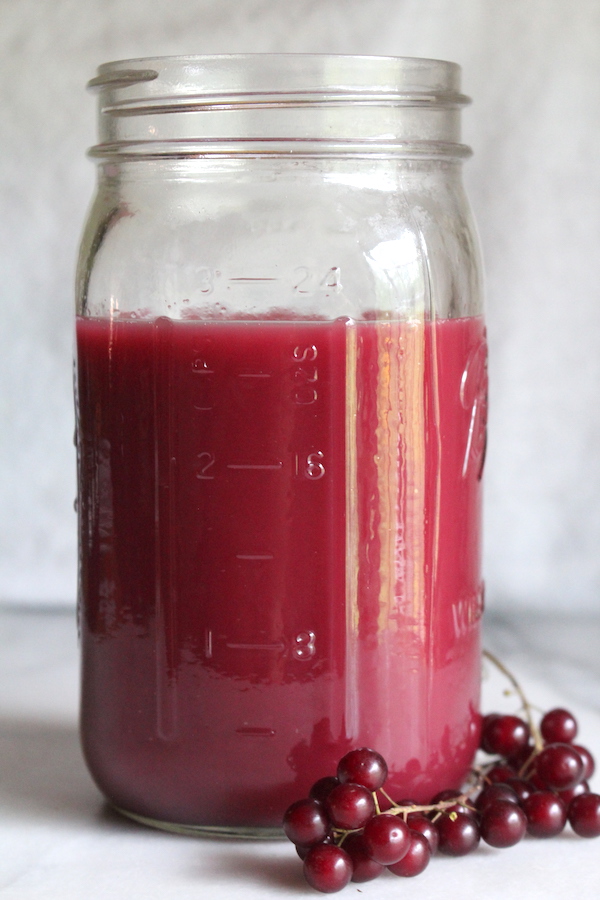
Chokecherry Jelly
Once you have chokecherry juice it’s really quite easy to make chokecherry jelly.
I cook 4 cups chokecherry juice with 2 cups sugar and the juice of one lemon. In my experience, it reaches the setting point reasonably quickly (about 15 minutes of hard boiling) and can be ladled into jars.
Be aware that chokecherries are wild fruits, so they’ll vary a bit in pectin quantity. Do a test batch and if you can’t get it to gel, go ahead and add commercial pectin on your next try. You can follow any cherry jelly recipe with pectin using chokecherry juice.
They’re acidic, so they’re perfectly fine for home canning, but it also works fine as a freezer or refrigerator jelly.
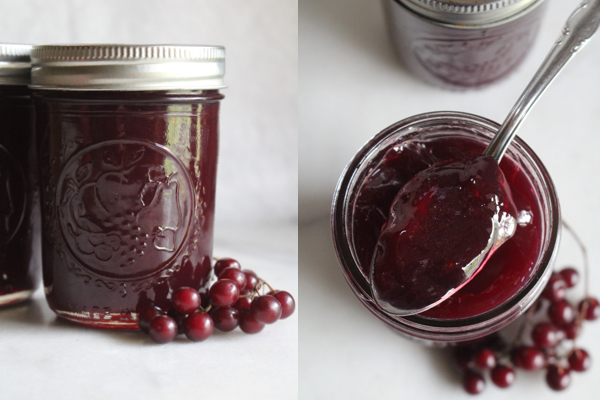
Chokecherry Syrup (and Cough Syrup)
Making syrup from chokecherries is similar to making jam, but the cooking time is much shorter. To make chokecherry syrup, simply add sugar to chokecherry juice and just barely bring it to a boil.
Stir to dissolve the sugar and then turn off the heat. Prolonged cooking will make chokecherry jelly as the pectin sets, but if you just dissolve the sugar it’ll stay as a syrup.
Wild cherry bark is often used to make cough syrup, though it’s usually wild black cherry (Prunus serotina). Chokecherries are closely related and the bark has similar properties. I’ve read that some people add fresh chokecherry twigs when simmering the chokecherries to extract their juice.
When they then make chokecherry syrup it contains both juice and a “tea” made from the twigs/bark, so it’s natural cough syrup.
I haven’t tried this method, but if you do, I’d caution you to be careful here. Cherry bark can be toxic if/when it ferments after harvest, so you’d need to use very fresh chokecherry wood. I wouldn’t try it unless I harvested living wood myself and put it directly into the pot that day.
As always, use your best judgment.
Chokecherry Soda
Homemade (or at least home flavored) soda is easy to make by combining a fruit syrup with seltzer.
The book Original local has a chokecherry soda recipe that suggests adding 2 tablespoons of chokecherry syrup to 1 (12 oz) can on seltzer, along with 1/4 cup of ginger ale or strongly brewed ginger tea (cooled). If you want a sweeter soda, you can also add more chokecherry syrup or maple syrup.
Personally, I prefer to make soda with water kefir so that it’s naturally carbonated and probiotic. Most water kefir recipes start with 1/4 cup of sugar to 4 cups water, but you can substitute 1/2 cup of chokecherry syrup in place of the 1/4 cup sugar. If you’d like to try it, I’d suggest this recipe for making homemade water kefir.
Chokecherry Wine
Winemaking is easier than you think, and you only need a little bit of specialized equipment to get the job done.
A narrow neck fermentation vessel (pictured below) to hold your wine, plus a winemaking airlock to keep it from turning to vinegar are the bare minimum. (Though even those can be fashioned from things in your kitchen if you’re creative.)
Before you get started, I’d recommend reading this beginner’s guide to small-batch wine.
I have a specific chokecherry wine tutorial coming shortly, but in the meantime, I’d suggest substituting chokecherry juice into my basic cherry wine recipe in place of sour pie cherries.
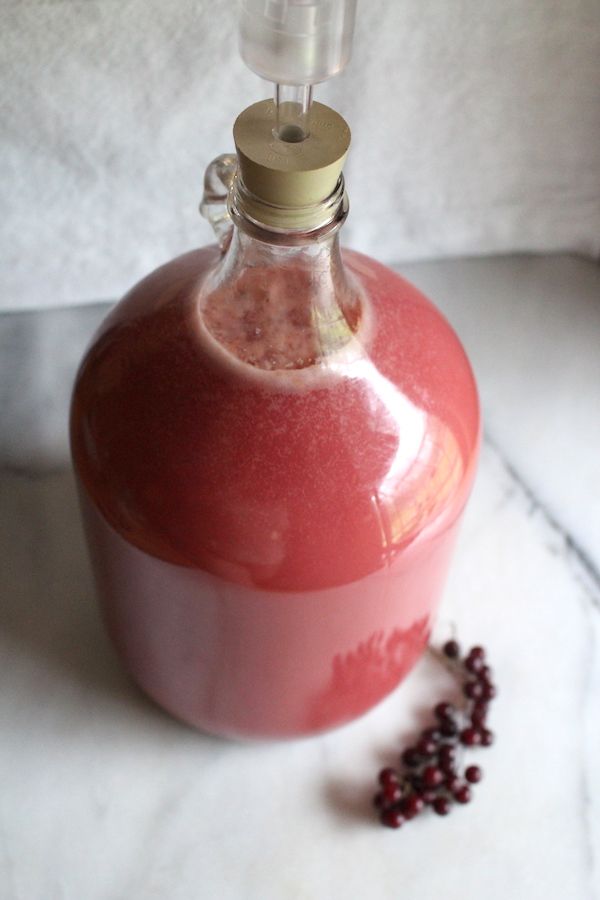
Chokecherry Vinegar
There are a couple of different ways to make chokecherry vinegar. You can make a simple infused vinegar by placing chokecherries (or chokecherry juice) in vinegar and allowing it to infuse for a few weeks. That’ll give you the flavor, without all the work of actually making vinegar from scratch.
If you’d like to try it though, you can juice the chokecherries and make a natural probiotic fruit vinegar at home. It’s not “hard” exactly since the fruit will naturally ferment into alcohol with the presence of surface yeast. Once there, vinegar-producing bacteria will naturally colonize (unless you work to stop them) and turn the alcohol into vinegar.
Making homemade vinegar is really just about directing the process ever so gently.
My friend Autumn Keim at A Traditional Life recommends adding 1/4 cup sweetener to each quart of juice before beginning the ferment to make chokecherry vinegar. From there, the process for making fruit vinegar is pretty straightforward and is more or less the same as making apple cider vinegar.
Chokecherry Pie
I’ll admit, I don’t think chokecherry pie is a good idea…
Sure, it can be done, but you’re going to have to first remove the pits by making juice, then use something to thicken the juice into a filling. It’s going to be more of a set jelly filling than a true fruit pie filling.
If you do want to try it, I’d suggest making a lemon meringue type pie but using chokecherry in place of the lemon. That way, the gel will be expected instead of a surprise inside what you’d otherwise expect to be a chunky fruit pie.
Dried Chokecherry Patties (Legren)
One of the most traditional ways to preserve chokecherries is as dried chokecherry cakes or patties. Fresh chokecherries spoil quickly, and since they were harvested in great quantity in season, it was important to preserve them as quickly as possible.
Instead of discarding the pits, as we almost always do these days, the chokecherries were pounded whole pits and all. They were then formed into patties or small cakes and dried in the sun. It’s thought that the sun drying denatured the toxins in the pits, and allowed the oil and flavor-rich seeds to be consumed as well.
If you’re skeptical about consuming the pounded chokecherry pits, I’d invite you to take a look at any of these historical resources that describe the process and how it renders the whole fruit suitable for eating:
- South Dakota State University Cooperative Extension Service
- How to Smash Chokecherries from Prarie Edge
- Making Chokecherry Pudding from Indian Country Today
- Chokecherry Processing from American Indian Health and Diet Project
Still, obviously, use your best judgment here. If you have a reaction to almonds, nuts or stone fruits you’ll want to avoid them altogether. Even still, it’s always possible to have a reaction to any new food, so proceed with caution.
Original local has a poem from an Ojibwe woman named Denise Lajimodiere that describes the traditional processing:
“After the first freeze
go out into the Turtle Mountain
bush to your favorite spot
you keep secret from all your cousins
and pick some chokecherries
when they are sweetest,
you won’t have to fight
mosquitos or ticks.
Have your grandkids help you pick.
Pound the chokecherries
on your Kookum’s
flat rock using her oval-shaped
pounding rock that fits snug in your hand.
Grind the pits as finely as you can.
Shape the pounded berries into small
“cookies,” and lay on an old window screen.
Put on top the lean-to where they will dry
slowly in the North Dakota sun.
Store in a cracker tin.
On Thanksgiving day put a couple cookies
worth in a cast iron skillet
with some water and set over a low fire,
when soft and starts to smell like summer,
add sugar and a pinch of flour to thicken,
stir in some bacon grease and fry it up a little,
put a small amount on your relatives’ plates,
kids too, and tell them they have to eat it, pits and all.”
We went through this process, pounding them with a mortar and pestle. I have to say, the result was absolutely delicious. As the pits are split they release an aroma that’s like sweet chocolate and almonds with hints of vanilla, and it’s truly heavenly. I can only imagine what that must have been like centuries ago when those flavors weren’t a part of your everyday pantry.
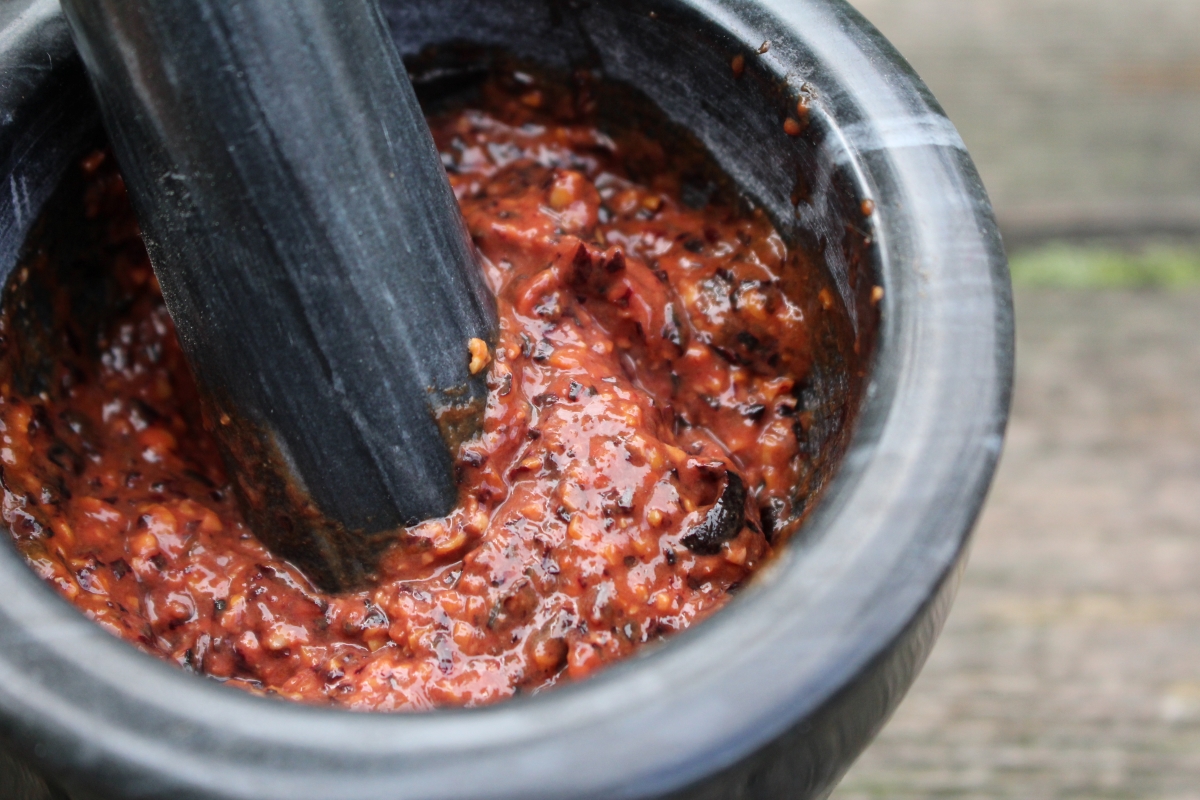
As they dry in the sun, the aromas fill the air and infuse into the whole chokecherry patty. You’re left with something that tastes like dried fruit infused with almond, chocolate, and vanilla.
I describe the entire process of making dried chokecherry cakes here.
When picked dead ripe, the chokecherries are quite sweet, and that sweetness is intensified in the drying process. The patties are basically chokecherry candy with nuts from the crushed pits.
The poem above describes cooking them into chokecherry sauce or pudding, which is done in different ways depending on the tribe. It goes by the name wojapi, biinettalappao, tenaaku, and probably other names as well. (I’ll discuss those all shortly.)
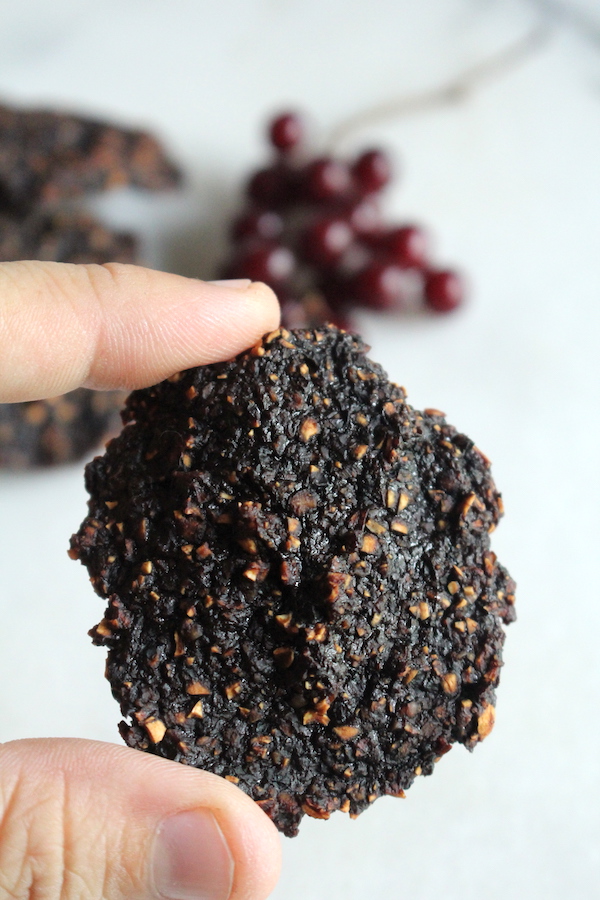
Chokecherry Fruit Leather (Oluwiminimus)
Since chokecherries are high in pectin, it’s easy enough to make fruit leather by mixing sugar with the juice/pulp and dehydrating on trays. That’d get you a smooth, pit-free fruit leather similar to what you’re used to with modern-style dried fruit leathers.
In the video below, Arthur Haines is demonstrating how to make a traditional style of fruit leather by processing both the fruit and pits together, so that you get the nutrition and flavor of both in the finished product.
This is similar to the dried chokecherry patties above, but made into fruit leather.
Wojapi (Chokecherry Jam/Pudding)
A traditional Native American dish, wojapi is somewhere between a traditional pudding and a jam depending on who you ask. Traditional puddings aren’t much like “pudding” we know of today, and are more like cream of wheat style dishes with savory/sweet ingredients cooked together and then served in a bowl.
I’ve seen a number of historical sources that say traditional wojapi is made with dried chokecherry patties (discussed above), simply cooked and rehydrated with a bit of water into a sauce. Sweetened sometimes, or other times not.
That means that the pounded chokecherry pits are still included in the finished dish, denatured by the drying process. It also means that it’s a bit like a nutty jam/fruit sauce since it has ground chokecherry pits included that give it a slight almond flavor.
I made it from chokecherry patties and it was delicious, with more complexity of flavor than a straight jam because of the inclusion of the aromatic crushed pits. Rehydrating dried chokecherry didn’t produce a smooth cooked jam, and it was a bit chunky.
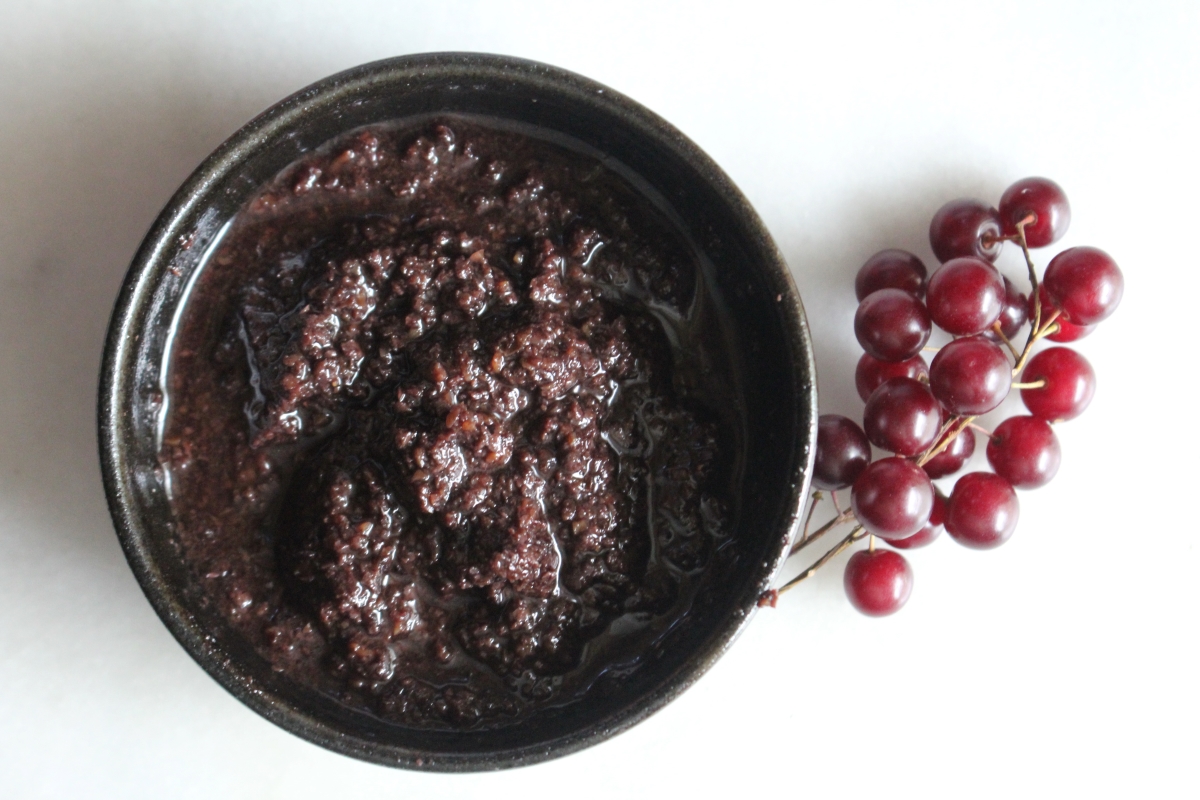
Other sources skip the drying with pounded pits and go with more of a straight jam.
The Sioux Chef has a recipe that’s more or less chokecherry butter, or a thick sauce made by simmering chokecherries with maple syrup. The author notes that:
“There’s no need to pit them because the pits drop to the bottom of the pot as the sauce becomes thick and lush. We’d sweeten it for a dessert or serve it as a tangy sauce for meat and game and vegetables, and as a dressing.”
His recipe starts with 6 cups of chokecherries (stemmed), adds 1 cup of water and honey or maple to taste. Cook until the chokecherries fall apart and the mixture thickens, and leave the pits behind in the pot when you serve.
The book also includes a recipe for Elk with chokecherry sauce that would use the savory version of wojapi without much in the way of added maple.
I made something similar to this and called it “chokecherry jam” because it contained fruit pulp (as opposed to jelly, which is fully strained). The jars were beautiful, but I found them a bit astringent. The cooked fruit pulp has more “choke” to it than the strained fruit juice. Somehow drying the fruits removes this astringency, and I’ll happily eat dried chokecherry fruit pulp in any form.
I’ll leave it up to your tastes to decide, but it does look darn pretty in a jar.
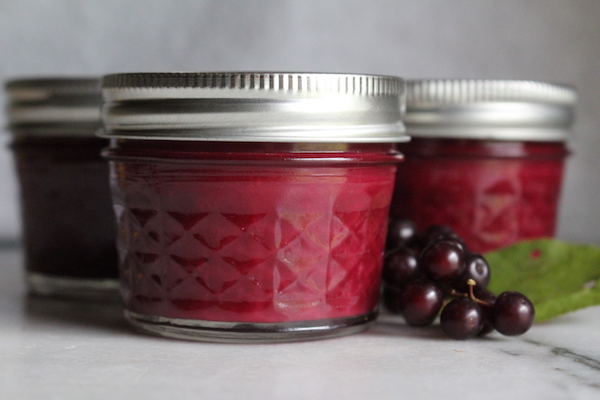
Native Chokecherry Pudding (Biinettalappao or Tenaaku)
While wojapi is sometimes known as “chokecherry pudding” most recipes I found produced more of a fruit sauce, either made with or without pits.
The Spirit of the Harvest has a recipe for chokecherry pudding that is made by a number of different tribes.
“The exact method for making chokecherry pudding or gravy varies from tribe to tribe and from cook to cook….An Arapaho cook from Wyoming…starts her gravy, called renaaku, by combining flour and butter in a skillet to make a light brown roux. She then stirs in the chokecherries, water, and sugar, and simmers until the mixture is thickened.”
The book also provides the Crow recipe for chokecherry pudding, or biinettalappao, which simmers fresh or dried chokecherries with a bit of water, then thickens with flour, cornstarch, or arrowroot.
The author notes that:
“The Crow harvest chokecherries in early August before they ripen fully and turn dark. When they are bright red, the pudding has a nice tang and the jelly has a prettier color…traditionally they were dried for winter use.”
These days they’re more often frozen instead of dried since freezers are readily available.
Pemmican
A traditional long-term storage food, pemmican is made from equal parts dried meat, rendered suet, and dried fruit. Traditionally it was made with dried chokecherry cakes because chokecherries were so incredibly abundant, and could be dried in anticipation of the autumn buffalo harvest.
The already dried chokecherry cakes were then mixed with dried meat and fat, and further pounded into cakes known as pemmican.
Other fruits were used as well, but chokecherries are usually associated with pemmican because they were harvested in great quantity.
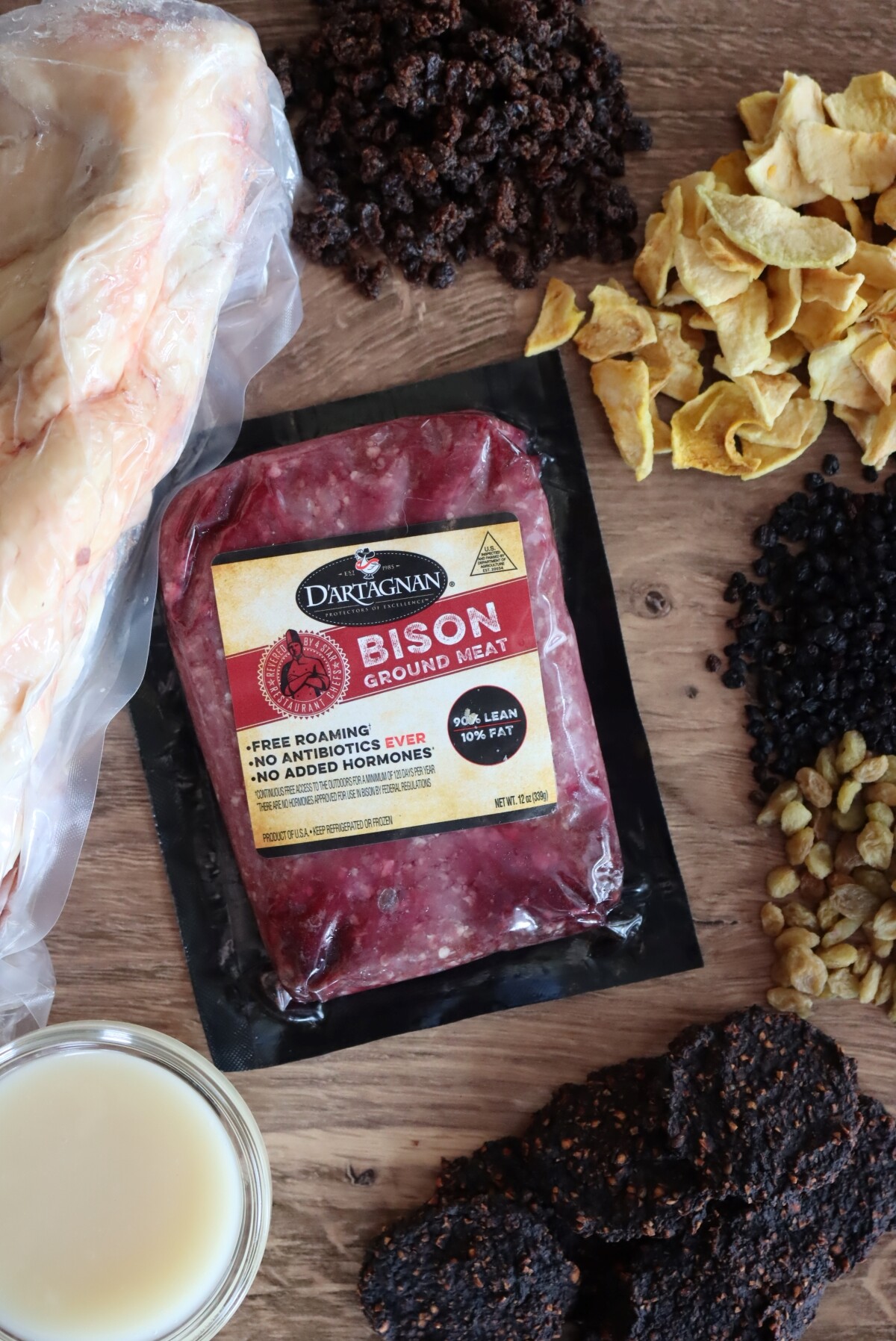
Dried Chokecherries
Instead of pounding chokecherries into cakes, you can also simply dry the chokecherries. Sarah at Roots School gave me this handful of chokecherries that she dried in her Excaliber Dehydrator. She just put them in and let it work until they were completely dry, no prep required.
I asked her about the toxins, and she said she wasn’t worried about it. She only eats them in very small quantities, literally a handful on top of granola or as a trailside snack. They taste like chocolate and the dried pit pops open with an almost rice crispy-like crunch. The opposite of what you’d expect, the pits turn really brittle when dried and crack easily when chewed.
I only tried a handful, literally this handful pictured below, but they were tasty. I’m honestly more comfortable using the traditional preparation which dries the pounded fruit in the sun, and since I do worry about the potential cyanide load from just drying them whole.
That said, this preparation does have its uses. Dried in this way, they can be then ground into chokecherry flour (discussed next). And also included is a way to denature the toxins in whole dried chokecherries.
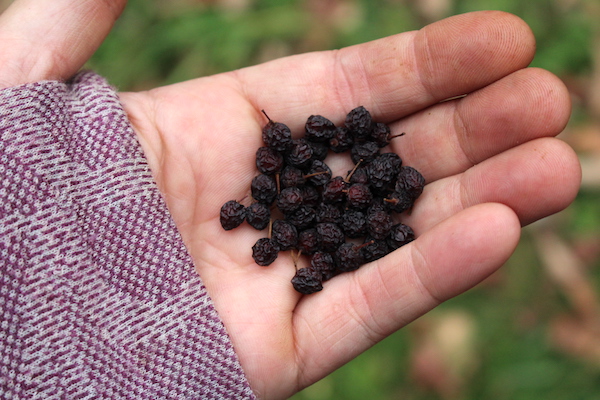
Chokecherry Flour (and Baked Goods)
A number of small wild Prunus species are first dried and then ground into flour around the world. Most notably, bird cherries in Scandinavia and Mahlab in the Mediterranean.
The Forager Chef’s Book of Flora has a discussion of working with stone fruit flours, along with many ideas and recipes (including a delicious-looking cake made with chokecherry flour).
“Although bird cherry flour, wajopi, and mahlab are made from different species of cherries in the genus Prunus (P. padus, P. virginiana, and P. mahaleb, respectively), these three terms all refer to the same general thing: a sort of seasoning or foodstuff made from pounding, drying or cooking wild cherries, yielding an end product that tastes strongly of almond and, in the process of drying and cooking, denaturing the cyanogenic glycosides people associate with bitter almond flavor….
To make it, dry whole wild cherries until cracker-dry in a dehydrator on high 140 degrees F (60 C) — it will take days — then grind to a powder, sift and bake with the sifted flour. The excess stones and shells can be used to infuse alcohol or other liquids, like wild cherry schnapps or noyaux infusion.”
He goes on to say that if you’re going to use the chokecherry flour in a raw recipe, as in an infused liqueur, he suggests spreading the whole dried cherries on baking sheets and toasting it at 300 degrees F (150 C) before grinding. While he’s been told by experts that the dehydrating process at 140 degrees is sufficient to denature the toxins, he notes that “it’s good to be overly cautious.”
Other Chokecherry Recipes
Beyond these ideas, you can honestly just use chokecherry juice anywhere you’d use other fruit juice.
We take the juice of elderberries and turn it into elderberry gummy bears, which my kids love. You could do the same thing with chokecherry juice.
Similarly, chokecherry lollypops can be made using any fruit juice lollypop recipe, like this wild blackberry lollypop recipe.
Or you can simply add plain gelatin and make chokecherry jello.
Use your imagination!
Wild Food Inspiration
Looking for more inspiration for cooking with wild foods?
- 60+ Dandelion Recipes
- 60+ Acorn Recipes from Around the World
- 50+ Ways to Use Yarrow
- 40+ Wild Foods You Can Make Into Flour
Foraging Guides
Foraging more than just chokecherries?
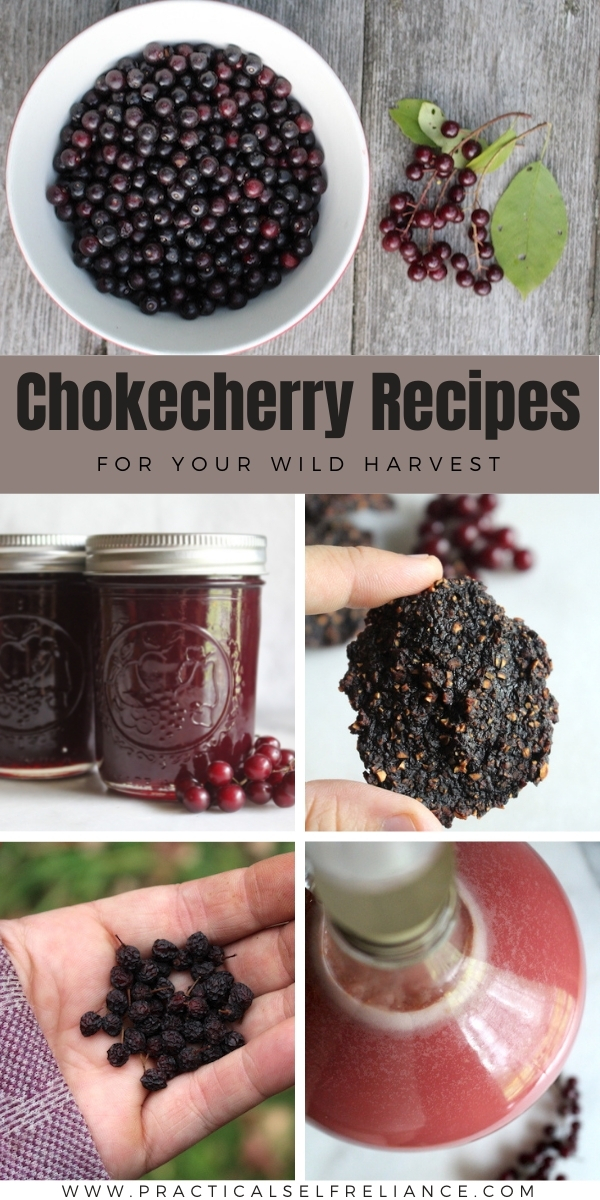
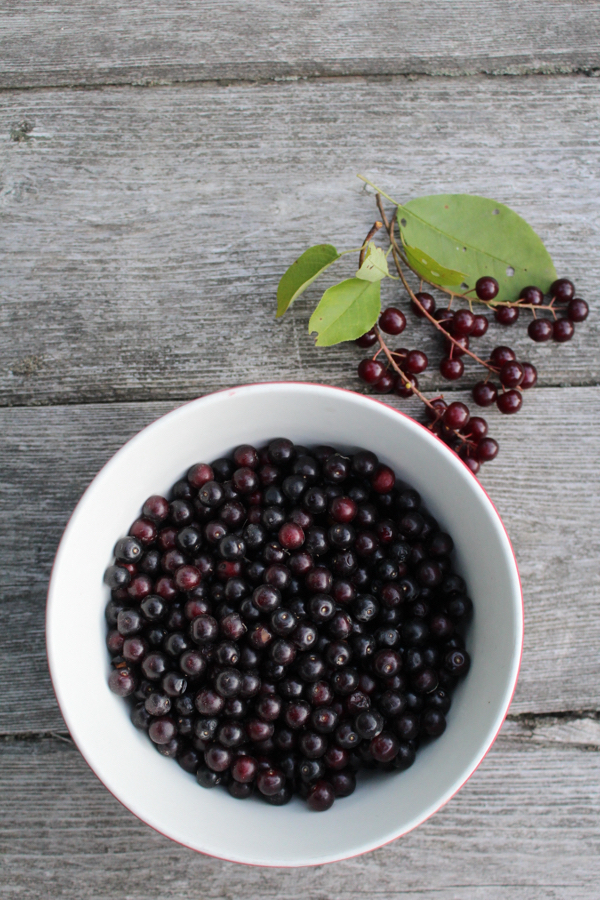

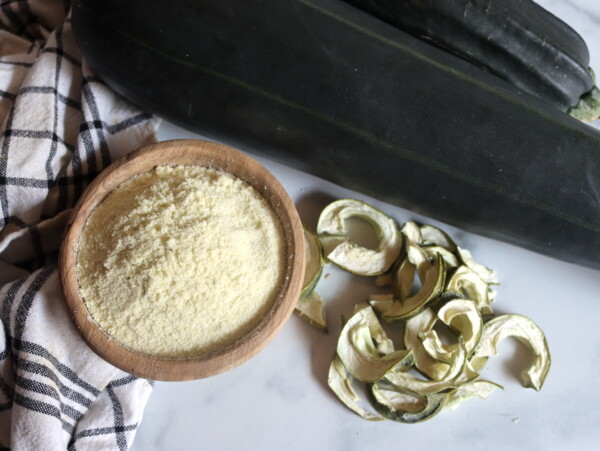

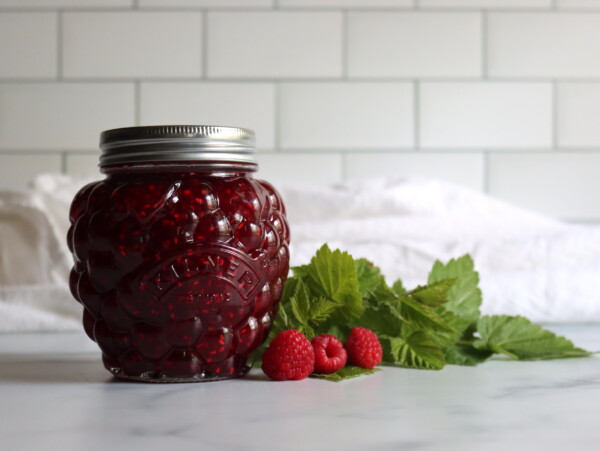










Oh, I forgot to mention, but another thing I want to try with chokecherries but haven’t yet is macerating in sugar. Just a different way of achieving syrup. I first did this with green pinecones (mugolio), and on a whim did it with Oregon grape berries also. What surprised and delighted me, and made me think this might be a great thing to do with chokecherries, is how much of the pit flavor got extracted with the Oregon grapes. Imparts a nutty, almond like flavor to the fruity tart plus sweet.
I love how thoughtful and thorough this page is! I’ve been making chokecherry juice and syrup for years. (My favorite way to enjoy the juice is after it ferments for a bit and gets fizzy and a tiny bit tart.)This is the first year I’ve tried pounding some into patties, pits and all. I agree, they were exceptionally delicious and aromatic! But I found it impossible to crush the shells enough to not have to be spitting out little pieces and shards. I really did try! Maybe my mortar and pestle is too small. Or maybe I just need a good solid metate? Thoughts? All the references I found said to “powder” the shells, but I wasn’t able to
I had really great luck just beating them into a pulp, and though there are still some good pieces in there, I found they were fine once the chokecherries were dried thoroughly. One trick a friend taught me is just drying the whole fruits, and then the seed kind of transforms to something that’s more akin to a “crackle” chocolate bar full of rice crispies. They crunch when you bit them, but softly. Unlike when they’re fresh and are very hard. I found with my patties it was the same thing, a crunch but a soft crunch that was nothing like when they were fresh. But, that may vary by region or plant, and you may not get as lucky. (Or, try spreading your patties very thin maybe and maybe more sunlight helps the seed chunks soften as they dry?)
Regarding pie, it is absolutely delicious if you just cook them whole with sugar and flour to solidify the juice a bit. They take a while to eat, but the taste is divine. We also make chokecherry pancakes with whole chokecherries and have them every second week year round – another quiet meal! These recipes came from my grandmother
And chokecherry jam has way more flavor than chokecherry jelly.
A Manitoba chokecherry lover.
Kihchi-marsii, thank you very much fir your writing.
I thought you might like to know that “Legren” is a Michif word meaning simply ‘berry’. For the plural, it would be “lii gren”. And, although the woman who wrote the poem may identify as Ojibwe/Anishinaabe, the word she uses for “grandmother” is not Ojibwe/Anishinaabemowin. It is Michif/Cree. Most of the people on the Turtle Mountain Reservation are actually Michif (Métis) and originally from is now called Manitoba, Canada.
That’s good to know, thank you!
I had an aunt who made Choke cherry pie. She used the whole cherry and called it a putt-putt pie. They called it this because people were too lazy to spit out the pits.
I love it. Thanks for sharing.
I have a recipe for Chokecherry Cheesecake which is absolutely fabulous! We have many chokecherries in our farm yard and always make syrup, jelly – love it!!
Thanks for the interesting aboriginal info.
You’re very welcome. The chokecherry cheesecake definitely sounds amazing.
Wild you share your chokecherry cheesecake recipe please? That sounds delicious!
My favorite right now is chokecherry sorbet. (4 cups cherries, 2 cups water, simmered and strained for juice, 1 cup sugar, 1\2 cup red wine, pinch of salt) Very rich deep flavor, and freezes very soft and scoopable in an ice cream maker.
This sounds amazing. Thanks for sharing.
Very interesting read. This is my first time doing anything with chokecherries. I did 6 jars of syrup and then I also did a more concentrated version with no sugar and poured that into an ice cube tray-good in a glass of apple juice. Just found this site looking also through recipes using lemons. Look forward to browsing here. Thanks
We just discovered chokecherries last summer when camping near a meadow randomly lined with the trees. We saw a man picking buckets full and asked how he uses them. He said they “make the best hooch!” Lol ok, well I took some home and made syrup and a chokecherry liqueur using vodka & sugar.
This year they weren’t quite as ripe during our camping trip, maroon to black, not all black, so about half came off the vine with tiny stems still attached. I’m trying to find trustworthy info on whether or not I actually need to remove the stems to make the liqueur.
It’s 2C chokecherries, 2C vodka, 1C sugar, soaked in a jar for 30 days or more. Then all the chokecherries are strained out, and you only drink the clear liquid in a spritzer or cocktail, not by the glassful obviously. No crushing or heavy stirring even, so no bits of stone or stem would be in the finished product.
I found one online nursery that sells CC trees and posted a recipe for CC wine where they specifically say you don’t have to remove the stems to make the wine. Of course all fruit/stems are strained out of finished product.
I can remove the stems from some of these, but it would be tedious to do the 7 gallons I picked. Do you think my liqueur recipe would be safe if 1/3 of the CC soaked in vodka/sugar, and then fully removed, had stems on them?
Thank you! I love the details and history you share!
I would think that if they are ok in the chokecherry wine then they should be ok in the liqueur as well. I would certainly try to remove as many as possible. It could possibly affect the flavor of the liqueur in addition to possible safety considerations. In most cases, these things only become problematic if they are actually consumed and since you are straining them out I wouldn’t personally be overly concerned. Of course, do your research and then just use your best judgement.
I appreciate your input, and I’ll keep researching. But I tend to agree with you…remove lots of stems but probably fine if some stay and get strained out.
This is not a comment on anything in particular, just a question. I didn’t fine a general area to send a question, so doing it here. Do you have any books published with all your recipes/ information?
I would love to have everything you do in a book!!
I don’t have a book of any kind, but perhaps someday when my kids are older I’ll put something together. For now, it’s just all online.
Thank you so much for all these recipes. I discovered a chokecherry tree on my property last year, and didn’t quite know what to do with the berries. I picked some and they dehydrated before I figured anything out. I believe I’ll try munching on a few of them now.